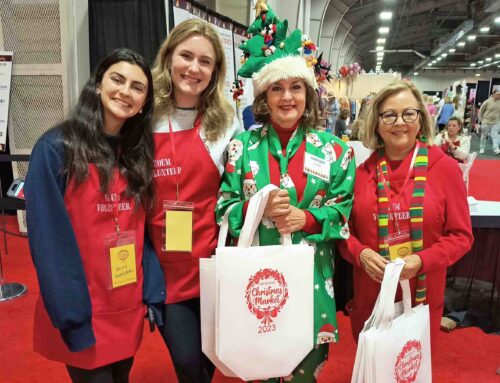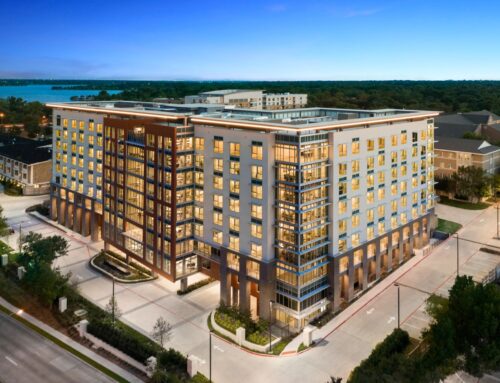Forty-three years ago, Dorothy Savage delivered her second daughter – and learned something important about herself.
Almost immediately after the birth, Savage faced societal pressure to give up her daughter “Dotsy”, who was born with cerebral palsy, deafness and impaired vision.
“It’s been extremely difficult,” says Savage’s older daughter, Virginia McAlester. “The schools for the deaf wouldn’t take a child with a cerebral palsy, and the schools that could take a child with cerebral palsy weren’t equipped to handle deaf children.
“There’s always been pressure to give Dotsy up, but it’s nothing my mother ever considered. She had a dream when Dotsy was born that she was climbing a series of hills. So she always felt that this was something she was supposed to do – take care of Dotsy.
“Mother tackles each problem one at a time.”
A Lifetime of Volunteerism
Look at the elegant, weathered, old-money homes of Swiss Avenue, and you would think these families have lived here forever. But for most, that’s not so. Just more than a generation ago, Swiss Avenue – an perhaps the rest of Old East Dallas – were headed for the crap heap of history.
Dorothy Savage was born into society on Swiss Avenue, but she discovered more important pursuits. When many others gave up and moved out, Savage decided neither she nor her neighborhood were going anywhere.
Largely through her efforts, families returned to our neighborhoods, which have become models for inner cities throughout the country.
For her ongoing work to preserve and enrich our diverse neighborhoods, Dorothy Savage is the first East Dallas/Lakewood Advocate Award winner. The Advocate Award annually honors an individual who has gone above and beyond the call of duty for our neighborhoods.
“My mother’s whole focus in life has been on being a volunteer,” says McAlester, who is a former president of the Historic Preservation League, which Save helped found. McAlester also is a neighborhood activist and co-author, with husband Lee, of a Field Guide to American Houses.
“Her friends complain she’s always off doing other things instead of coming to the women’s club for lunches and study groups. In her generation, that’s what a lot of her compatriots did with their time. It’s shocking in today’s world to think of all that wasted women’s power.”
Bob Booker, director of the Vietnamese Mutual Assistance Association on Bryan Street, says Savage “seems able to cross all economic and cultural barriers. She does not seem to be afraid of anything. She’s probably the furthest thing from a snob I know and is very much a lady herself.”
Still, Savage spares a little time for society: She has served as president of the Junior League and the Dallas Women’s Club, and a daughter and granddaughter have “debuted” into Dallas society.
And yet, says husband and former Dallas mayor Wallace Savage: “Dorothy is distinguished by getting out and laboring in the neighborhood. That is her nitty gritty.”
Standing Her Ground
When she’s compelled to fight, Savage does so. She stood in a Swiss Avenue median in 1951, blocking park department workmen from cutting down the evergreens growing there. Twenty years later, she led a movement to stop the City’s plan to expand Roseland Parkway into a six-lane freeway.
But Savage prefers to bring people together to solve the universal problems of crime, poverty and unemployment that threaten quality of life.
“I ask myself: ‘Who is the right person to do this job?’” Savage says. “I think I’m pretty good at putting the job together with the right person. They’re more likely to say yes if it’s something they like doing.
“One person can’t make a difference if they’re going to try and do it all themselves. You need to network, bring other people into it, and then the project gets done.”
Peggy Walker, a member of the Old East Dallas Coalition says: “Hanging around Dorothy is like getting a Ph.D. in human relations. She knows how to make things work out for everybody, because she knows how cities and governments work.”
Growing Up On Swiss Avenue
Savage has never left Swiss Avenue for long.
She grew up on Swiss Avenue in a house not far from today’s Baylor Hospital campus, attending Lipscomb Elementary and Hockaday when the school was located in East Dallas. She later attended Wellesley, graduating with a math degree.
Savage met husband-to-be Wallace in 1939, when a mutual friend asked them to go sailing at White Rock Lake.
“After we had been sailing, the friend decided to pretend he was asleep so that Wallace would have to do all of the work when we got to the dock.
“But Wallace figured out what he was up to, so Wallace tried to play a trick on him by kicking the boat off after docking so the friend would wake up asleep in the middle of White Rock Lake.
“Well, Wallace ended up falling into the water, waist deep, when he kicked the boat and missed. I had to laugh at that.”
Their first formal date was at the Baker Hotel for the Idlewild Club’s Cotillion, when debutantes are presented to Dallas society. Although Wallace Savage was a member of the Dallas men’s social group, it was Dorothy Savage’s first Cotillion.
“I was impressed,” she says. “There was a chemistry between us.”
They were married on Columbus Day in 1940, and Wallace Savage’s naval duty took them to Washington and Boston, among other ports, during World War II. Following the war, the Savages returned to Dallas to re-establish roots in East Dallas and begin a lifetime of civic activism.
The War Come to Old East Dallas
“When we came back from World War II, Wallace and I bought a house across the street from where we now live (in her parents’ house),” Savage says. “We had two little girls, and we decided we would like to stay there. We were going to fight rezoning, and try to maintain the neighborhood.”
During the war, many of the grand, old houses on Gaston, Fitzhugh and Swiss avenues were divided into multi-family units. Slumlords moved in and accelerated the process, threatening the neighborhood.
That’s when Savage made her first stand.
She organized a group of homeowners who convinced the City to rezone Swiss for luxury apartments, and the tight restrictions blocked opportunistic developers.
At the suggestion of City planner Weiming Lu, Savage and her neighbors began working in 1970 to create the City’s first historic district. And in 1972, the Historic Preservation League was born.
Meanwhile, Savage and her husband, who served as Dallas mayor from 1949-51, bought and restored two Swiss Avenue houses and sold them to families who were willing to brave the still-challenging urban environment.
The Preservation League eventually bought the houses on the Wilson block of Swiss Avenue and sold them to the Meadows Foundation, which invited non-profit agencies to move in. In the mid-1970s, the league established a revolving fund, buying and selling 27 houses in Munger Place.
Pioneering in East Dallas
Trudy O’Reilly was one of the urban pioneers who in 1974 bought a condemned house in Munger Place for $12,000.
“I was in my early 20s when Dorothy introduced me to the Historic Preservation League,” O’Reilly says.
“I felt just like it was wrong that those beautiful, old houses were being redlined. The banks had decided they would not secure loans in the area, and people couldn’t borrow money.”
O’Reilly later served a term as president of the Historic Preservation League and is president of the City’s Landmark Commission.
“Dorothy showed me people could make a difference,” she says.
In recent years, Savage brought together business and neighborhood interests to plan the traffic bypass that revitalized the Lakewood Shopping Center. She also helped create the Old East Dallas Coalition, an umbrella group for neighborhood associations, and she remains a catalyst for the coalition’s Crime Watch Task Force.
“Everybody else gets burn-out,” says Peggy Walker, who admits that her Crime Watch activity took a personal toll. “Dorothy doesn’t. She has more energy and vitality than anybody you’ll ever meet.”
Help For Those Who Need It
Although much of Savage’s work benefited the comfortable families who live in Old East Dallas, she also has devoted her attention to other, less fortunate residents.
“Dorothy learned about problems in the Asian community and organized a committee of the Old East Dallas Coalition to the address those problems,” says Mary Poss, executive director of the Greater Dallas Crime Commission.
“She brought together health-care officials, job placement representatives, police officers, employers and Asian leadership and networked everybody so they could learn how to work together.”
Outside East Dallas, Savage has been involved in creation of the South Boulevard/Park Row Historic District and restoration of the F.A. Brown Farmstead on Inwood Road near Love Field. Currently,s he’s promoting a special zoning overlay to help clean up the embattled Columbia-Carroll area by requiring bars and liquor stores to acquire special-use permits.
More to Come
Today, Dotsy Savage rides DART buses “all over town”, sister Virginia McAlester says, a tribute to her mother’s belief in the “right to risk”.
“It’s ironic that my mother spent all of these years taking care of my sister, and now she’s recovering from an illness herself.”
While neighborhood issues and unsavory developers failed to slow her, a recent stroke has created a new personal challenge for Savage. During the past few months, she has been rehabilitating at Baylor Medical Center, and she recently returned to her Swiss Avenue home for further rehabilitation.
How ill the illness affect her neighborhood activism?
“Dorothy is a tremendous model of leadership for all of us to follow,” says Poss of the Crime Commission.
Says Walker: “She has always been to me the most vibrant person. She has such energy and enthusiasm for life.”
Savage is most proud of her work to preserve our neighborhoods.
“The preservation projects, I think those have made a tremendous impact on East Dallas and on all of Dallas,” she says.
“Preservation sort of glamorizes everything else around it. It has a public relations value that everything else is lacking. Without preservation efforts, I think if you look at parts of Live Oak and Gaston, you have a pretty good idea of what all of Old East Dallas would look like.”
Savage intends to continue concentrating on preservation and graffiti-removal projects during the next few years. And she is optimistic about the future of East Dallas and Lakewood.
“I think the neighborhoods will be even more stable than they are now, and because of that, the retail areas will become even better.”
If she’s right, her efforts will be largely responsible. But Savage defers credit for her accomplishments. That would contradict her view of an East Dallas where everyone contributes to the scenery.
“What’s so wonderful about East Dallas is the variety,” Savage says. “We have a wonderful opportunity to show that all nationalities and all age levels and all economic groups can live and work together. We’ve been doing it, and we should continue to do it.”





